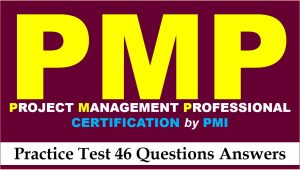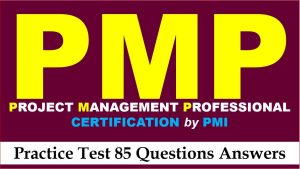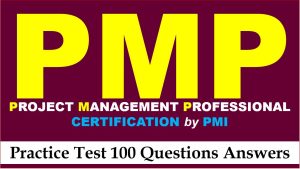Hi PMP aspirants, welcome to AKVTutorials. Ready to evaluate your knowledge of PMP concepts through scenario-based practice questions that mirror real-world project scenarios? Evaluate your readiness for real-world scenarios with our scenario-based PMP Project Management Professional practice questions, a key to comprehensive preparation. In this article, you will get PMP Exam Prep Test 26 Questions With Explanations. PMP (Project Management Professional) is a certification offered by PMI (Project Management Institute) to get a skill managing the people, processes, and business priorities of professional projects. The PMP certification holders are called Project Manager who have proven they have project leadership experience and expertise in any way of working.
PMP Exam Practice Questions
PMP Practice Test Question No 1
Being assigned as a project manager, you noticed during project execution that conflicts arise in the team on both technical and interpersonal levels. What is an appropriate way of handling conflicts?
Option A : Conflicts distract the team and disrupt the work rhythm. You should always smooth them when they surface.
Option B : A conflict should be handled in a meeting so that the entire team can participate in finding a
solution.
Option C : Conflicts should be addressed early and usually in private, using a direct, collaborative approach.
Option D : You should use your coercive power to quickly resolve conflicts and then focus on goal
achievement.
Show/Hide Answer
Answer Keys: YES
Explanation: No
Correct Answer: C
Conflicts should be addressed early and usually in private, using a direct, collaborative approach.
PMP Mock Test Question No 2
What is the purpose of a project charter?
Option A : To formally authorize a project or a phase and document initial requirements which satisfy the stakeholder’s needs and expectations.
Option B : To document how the project will be planned, executed, monitored/controlled, and closed.
Option C : To link the project, which is going to be planned, executed, and monitored/controlled to the ongoing work of the organization.
Option D : To describe the process of performing the work defined in the project management plan in order to achieve the project’s objectives.
Show/Hide Answer
Answer Keys: YES
Explanation: No
Correct Answer: A
To formally authorize a project or a phase and document initial requirements which satisfy the stakeholder’s needs and expectations.
PMP Practice Exam Question No 3
Which is a central objective of using a Kanban board?
Option A : Allowing for three-point estimation of work items
Option B : Limiting the number of items in the Work in Progress column
Option C : Allowing for Fibonacci numbers in estimation of epics
Option D : Giving the Scrum Master a tool to add stories to the backlog
Show/Hide Answer
Answer Keys: YES
Explanation: No
Correct Answer: B
Limiting the number of items in the Work in Progress column
PMP Mock Exam Question No 4
What does the term continuous delivery often refer to?
Option A : A standardized set of deliverables, like plans, reports, and checklists.
Option B : A set of tools and techniques that a project manager should master.
Option C : Increasing customer satisfaction by delivering valuable products and increments early.
Option D : A specific sequence of work, described in terms of soft logic.
Show/Hide Answer
Answer Keys: YES
Explanation: No
Correct Answer: D
A specific sequence of work, described in terms of soft logic.
Project Management Professional Question No 5
The communications management plan is a document which includes descriptions of
Option A : Project level performance reports
Option B : Activity level status reports
Option C : Stakeholder communication requirements
Option D : Project benefit analysis results
Show/Hide Answer
Answer Keys: YES
Explanation: No
Correct Answer: C
Stakeholder communication requirements
PMP Certification Prep Question No 6
_________ are usually not a manifestation of unique organizational cultures and styles.
Option A : Shared visions, values, norms, beliefs, and expectations
Option B : Individual traits and attitudes of co-workers
Option C : Views of authority relationships
Option D : Policies, methods, and procedures
Show/Hide Answer
Answer Keys: YES
Explanation: No
Correct Answer: B
Individual traits and attitudes of co-workers
PMP Exam Question No 7
Which of the following are generally regarded as elements of active listening?
Option A : Making eye contact
Option B : Pressurizing the speaker
Option C : Paraphrasing
Option D : Interpreting the information
Option E : Interrupting when appropriate
Show/Hide Answer
Answer Keys: YES
Explanation: No
Correct Answer: A,C,D
Making eye contact, Paraphrasing, Interpreting the information
PMP Exam Sample Question No 8
As the project manager, you decided to arrange a team meeting to identify and analyze lessons learned from quality control with stakeholders. What should you do with them?
Option A : Document them and make them part of the historical database for the project and the performing organization.
Option B : Discuss them with management and make sure that they remain otherwise confidential
Option C : Publish them in the corporate newsletter.
Option D : Follow your strategic decisions, independent from lessons learned. These decisions have been made and should be implemented whatever the outcomes are.
Show/Hide Answer
Answer Keys: YES
Explanation: No
Correct Answer: A
Document them and make them part of the historical database for the project and the performing organization.
PMP Exam Practice Question No 9
Your Scrum Team is working with a Product Owner. During daily Scrum meetings, the person criticizes your team’s perceived “dysfunctionality” and requires that one developer should be delegated to take the lead? What could be an appropriate response to that? (Choose 2)
Option A : The Product Owner’s job is to guide the direction of the product.
Option B : The Product Owner’s job is to validate the final deliverables of the project.
Option C : The Product Owner’s job is to verify that the rules of Scrum are adhered to.
Option D : The Product Owner should not join the Daily Scrums as he/she is not a member of the Scrum Team
Option E : The Product owner manages the product backlog for the Developer Team.
Show/Hide Answer
Answer Keys: YES
Explanation: No
Correct Answer: A,E
The Product Owner’s job is to guide the direction of the product, The Product owner manages the product backlog for the Developer Team.
PMP Certification Exam Question No 10
How should change management be planned for?
Option A : Changes are generally not predictable, therefore planning for change management cannot be reasonable.
Option B : Planning for change management should be done while the various change control processes are being applied.
Option C : Change management can be planned in a set of management plans or a specific change
management plan.
Option D : Changes are a sign of bad planning. One should avoid changes during a project, thus eliminating the need to manage them.
Show/Hide Answer
Answer Keys: YES
Explanation: No
Correct Answer: C
Change management can be planned in a set of management plans or a specific change management plan.



